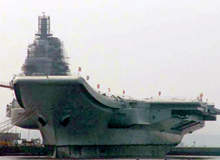
The slower something moves, according to cognitive psychologists, the less likely people are to view it as a threat. Slow progress, however, is not no progress – even tiny movements can produce big results over a sufficiently long timeframe.
A case in point is China’s aircraft carrier programme. Observers following the saga of the Varyag, the partially built Soviet aircraft carrier purchased by China from Ukraine in 1998, have speculated for years about the vessel’s ultimate purpose. Construction on the Varyag stopped with the ship only 60% complete, and lacking electronics and propulsion systems. Did the Chinese plan for, then abandon, a massive retrofit?
In fact, the Varyag may already be performing its ultimate mission of training the next generation of Chinese sailors and naval aviators. More broadly, the Varyag is but one step in the proverbial thousand-mile journey, the outline of which is clearer with some long-term perspective.
CHINESE CARRIER AMBITIONS
Indeed, the first clear evidence of China’s carrier ambitions emerged two decades ago. In 1985, China bought a decommissioned Australian aircraft carrier for scrap – but before it went under the torch, Chinese engineers apparently studied the ship’s design and used the flight deck for pilot training.
After the fall of the Soviet Union, Chinese companies bought two decommissioned Russian anti-submarine carriers, the Minsk and Kiev. China converted both to civilian purposes, but again, Chinese naval architects had the opportunity to study both.
Sandwiched between these sales was the deal for the Varyag, which did not actually make it to China until 2002 because Turkey feared that the vessel, which required towing, could founder in the Bosphorus and impede shipping. After an extended drydock visit, the Varyag was moved to the northern Chinese port of Dalian, its current residence.
Recent speculation over the uses of the Varyag has focused on the repainting of the ship in navy gray and its apparent inactivity in terms of civilian uses. Although these facts are suggestive, they are not as significant as the tight perimeter security surrounding the ship.
Most significantly, China reached a deal with Russia in late 2006 for up to 50 Su-33 fighter aircraft, which the Sukhoi aviation bureau designed specifically for carrier operations.
While some analysts believe that China wants to deploy a carrier by 2010, skeptics raise a number of questions that cast doubt on the existence of such a goal. However, alternative answers are available for these questions – and taken together, the ‘column B’ answers are even more worrisome for those nations, such as India, who fear China’s regional ambitions.
CARRIER PROGRAMME QUESTIONS
Why was the Varyag was bought stripped? In an age of rapidly evolving technology, China may have believed that the original electronics suite was obsolescent anyway. Similarly, China may have felt that its own steam turbine technology would be an improvement on the earlier-generation Russian propulsion systems, which were never the most reliable to begin with. What mattered was the implementation and effectiveness of the Varyag’s structural design – the element of the ship least sensitive to technological change.
If seagoing aviation is so important to China, why did it scrap the Minsk and Kiev? Tellingly, the Soviets classified these ships as ‘heavy aircraft-capable cruisers’ primarily oriented toward anti-ship and anti-submarine operations.
China does not want a carrier for these reasons: consistent with its vision of asymmetric warfare, China would attack US surface warships with subs and long-range missiles, and may regard US sub-hunting as an overly challenging and expensive proposition relative to the rewards it could plausibly bring. China wants a carrier for the same reasons that US war planners like them so much: flexible inshore and overland power projection in remote locations such as the Indian littoral and Persian Gulf, which carries an ever-increasing supply of inbound oil and outbound trade.
Why did the Chinese reportedly decline French and Spanish offers to build carriers for them in the 1990s? Tellingly, the Chinese were least impressed by the French offer, which was contingent on Chinese purchases of the accompanying electronics and aircraft (unlike the Russian fire sales of stripped-down vessels). Given its great-power aspirations, China probably feels duty-bound to make rather than buy – and may believe the learning experience of building its own may be more beneficial in the long term.
In this light the long gestation period of the Chinese aircraft carrier programme results neither from technological backwardness nor low prioritisation, but rather from a ‘just-in-time’ approach to assembling components of a grand maritime strategy.
- Don’t operate a carrier until US carriers can be neutralised
- Don’t subject a carrier to sea trials until the associated aircraft and pilots have been tested and trained – which can be done initially through simulated ‘short runway, timed landing’ training on land
- Don’t fit a carrier out until the last minute, to allow component technology to develop as much as possible.
Patience, it seems, is not only a virtue, but good common sense as well.







